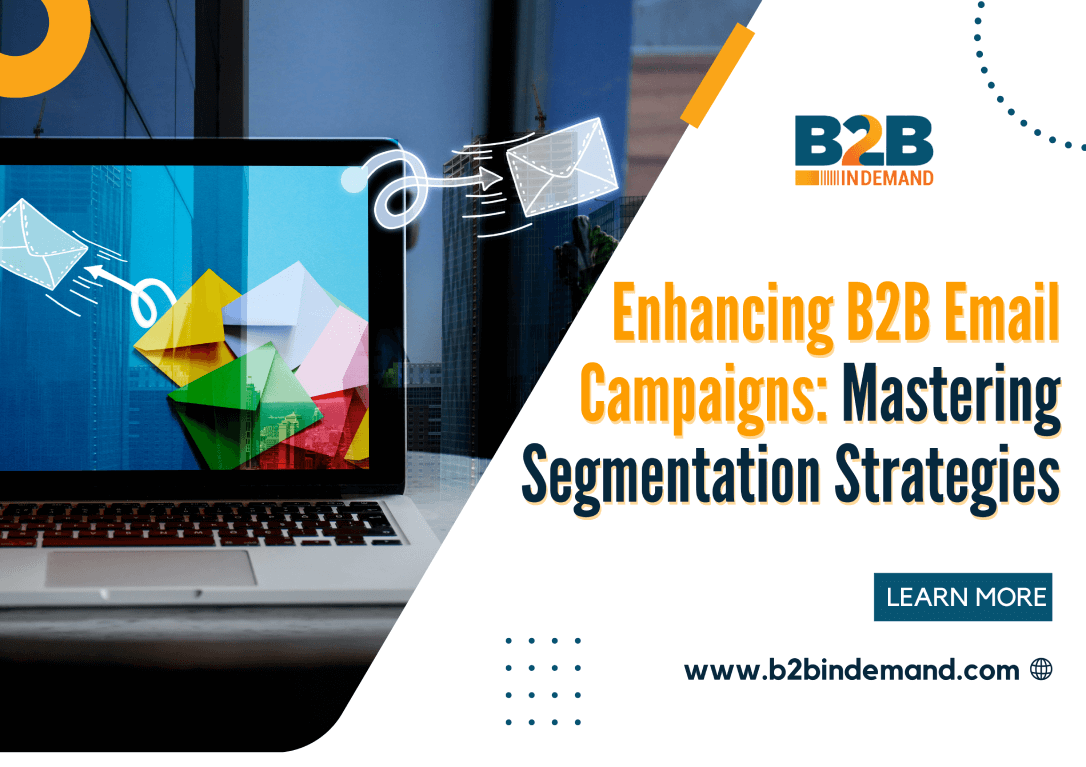
B2B Email Campaigns: Mastering Segmentation Strategies for Success
Entering the digital age has revolutionized B2B marketing, particularly in the realm of B2B email campaigns. Mastering the art of segmentation within email marketing is pivotal to engaging audiences and achieving high conversion rates. This deeper level of personalization is not just a feature; it’s a necessity for resonating with our varied audience. Let’s delve into the core of email segmentation strategies and explore how tailored content can profoundly impact our B2B outreach efforts.
B2B Email Campaigns: Segmentation Strategies:-
1. Firmographic Segmentation:
Firmographic segmentation in B2B email marketing involves categorizing businesses based on specific attributes to create tailored content. This method relies on various company characteristics like industry, size, location, revenue, or even technological infrastructure. By leveraging such data, we can craft email campaigns that resonate with each segment’s distinct needs and pain points, ultimately improving relevance and engagement. This approach optimizes our communication by delivering targeted content that aligns with the unique requirements of diverse business profiles.
2. Behavioural Segmentation:
Behavioral segmentation in B2B email marketing revolves around analyzing the actions and interactions of potential clients or prospects. It focuses on understanding how these recipients engage with content, past purchases, or responses to previous emails. By comprehensively examining these behaviors, marketers can craft highly personalized email campaigns. This approach enables the delivery of content that aligns with the recipient’s interests and preferences, thereby increasing engagement and the likelihood of conversion. Behavioral segmentation enhances the targeting of specific needs and interests, leading to more effective B2B email campaigns.
3. Purchase Intent and Stage in the Sales Funnel:
Purchase intent and stage in the sales funnel are crucial factors in B2B email segmentation. This approach involves segmenting recipients based on their positions in the buying process. By recognizing where prospects are within the sales journey, marketers can tailor content to meet their specific needs and interests. Segmenting based on purchase intent and the stage in the sales funnel allows for the delivery of more relevant and compelling content. For instance, prospects in the awareness stage might receive educational materials, while those in the consideration stage might get more detailed product information. This strategic segmentation improves engagement and nurtures leads effectively through the buyer’s journey.
4. Personalization Techniques:
Personalization techniques in B2B email segmentation involve tailoring content, subject lines and offers to meet the unique needs and preferences of diverse segments within the audience. This approach allows for the creation of more relevant and engaging email campaigns. By personalizing emails according to specific attributes or behaviors of the recipients, such as their industry, purchase history, or previous interaction with the brand, marketers can significantly enhance engagement rates and foster stronger connections with the target audience. This customization contributes to higher open and conversion rates, as it speaks directly to the needs and interests of each segment, thereby increasing the overall success of email campaigns.
Data Quality and Management:
Data quality and management play a crucial role in B2B email segmentation. It involves ensuring that the information utilized for segmenting the email campaigns is accurate, updated, and relevant. Having clean and high-quality data is essential for effective segmentation. This process requires continuous efforts to maintain and refine data quality by verifying, correcting, and updating the information to ensure its accuracy and reliability. With robust data management practices, businesses can better target their email campaigns, ensuring that the right content reaches the right audience segments. The effectiveness of segmentation heavily relies on the reliability and accuracy of the data, allowing for more successful email marketing initiatives.
Automation and Dynamic Segmentation:
Automation and dynamic segmentation are pivotal elements of B2B email segmentation. Automation streamlines the process of segmenting the email list, ensuring that the right content reaches the appropriate audience segments. It involves setting up rules or parameters that automatically categorize subscribers based on their behaviors, interests, or demographics.
Dynamic segmentation goes a step further by continuously updating segments based on the changing behaviors and preferences of recipients. It allows for real-time adjustments to segment criteria, ensuring that the content delivered to subscribers is always relevant. This ensures that each email is tailored to the specific needs and preferences of the recipients at the time of sending, thereby increasing engagement and relevance. These dynamic and automated segmentation practices are instrumental in enhancing the efficacy of B2B email campaigns.
Measuring Success and Iteration:
Measuring success and iteration in B2B email segmentation involves evaluating the performance of email campaigns based on predetermined metrics. It includes examining factors like open rates, click-through rates, conversion rates, and overall engagement. The collected data is analyzed to gain insights into the effectiveness of the segmentation strategies.
Iteration involves using these insights to refine and improve future email campaigns. This process encompasses adjusting segmentation criteria, refining personalization techniques, or optimizing content based on the performance data obtained. It’s an iterative process where success metrics guide the refinement of future campaigns, ensuring that B2B email segmentation strategies evolve and improve over time. This continuous improvement cycle is vital for maximizing the impact and effectiveness of B2B email campaigns.
Conclusion:
Effective B2B email segmentation is a linchpin in achieving impactful marketing strategies. Firmographic segmentation enables tailored content that resonates with diverse industries, sizes, and locations. Behavioral segmentation dives into recipient actions and preferences, driving tailored content. Segmenting based on purchase intent and funnel stages refines targeting and optimizes conversion pathways. Personalization techniques add depth, enhancing engagement and conversion. Maintaining data quality is foundational to ensuring precision in segmentation. Automation and dynamic segmentation fortify timely and customized content. Measuring success and iteration closes the loop, offering insights for refined future strategies. Employing these practices is the recipe for elevated B2B email campaigns that resonate, engage, and convert, forming an indispensable part of a successful B2B marketing arsenal.
